An effective content strategy establishes your content production plan from brainstorming sessions and drives you toward your targets.
It helps validate your brand authority, build trust with readers and potential buyers, and scale your business. You can harness the trust to realize your aim.
However, you must carefully develop a viable content creation strategy that aligns seamlessly with your business objectives to drive traffic and convert readers.
A robust content strategy captivates readers, prioritizes exceptional content quality, and evaluates results to ensure continuous improvement.
Developing a successful content strategy that drives results will guarantee that your small business uses content efficiently and thrives quickly with significant results. Do you need one for your business?
This guide delves into the following three primary areas:
- What is a content strategy in digital marketing
- Why content strategy matters to your business
- How to build a result-oriented strategy for your business website
Let’s get started…
Table of Contents
What is Content Strategy in Marketing?
Definition of content strategy: A content strategy is a durable plan that helps you create and share valuable information about your products or services to get the right people interested in your offer.
It’s a way to attract leads, keep them engaged at every stage of their journey, and build a community of loyal fans around your business.
The purpose of a sustainable strategy is to:
- Produce quality content that resonates
- Create awareness for your product or service
- Gain readers’ trust
- Build brand authority
- Attract more visitors to your online real estate
- Make readers take the desired action
Primarily, you need a content strategy as a workflow for content creation from ideation to publication. It ensures efficiency, quality, and consistency.
Why Does Your Business Need a Content Strategy?
A strategy for your business content is vital because it provides a blueprint for creating, optimizing, and distributing relevant marketing messages that meet the reader’s needs.
It is a crucial plan outlining the steps, structure, tools, and other elements throughout the content development lifecycle. This content plan helps you create relatable marketing messages that connect and convert readers.
Moreover, marketers/brands need a strategy for content creation because it helps:
- Boost SEO campaigns
- Build awareness for your products or services
- Increase audience engagement
- Attract quality leads
- Improve conversions
Your small business needs a practical content creation strategy to ensure a focused and effective marketing effort.
How to Create a Content Strategy That Works
A well-established content strategy framework is your roadmap to creating marketing content that aligns with your business goals and audience needs.
Use these nine steps to build a convincing strategy framework:
- Outline your content strategy objectives
- Research your target audience
- Audit competitor’s content strategy
- Develop a unique voice for your content
- Brainstorm content ideas and formats
- Research competitors’ content distribution platforms and find what works
- Develop a robust content calendar
- Record your content strategy
- Measure and refine content performance
1. Outline Your Content Strategy Objectives
As a content marketer, you don’t create content only to drive traffic and get clicks. You produce valuable information and insightful data to achieve an intended objective(s).
So, the first step to creating a practical content strategy framework involves defining and outlining your content marketing objectives or goals.
Before proceeding, it’s advisable to ask yourself some thought-provoking questions, such as:
- How and where does my target audience consume content?
- What content formats (blogs, videos, podcasts) resonate best with them?
- What unique value can my content offer to differentiate my brand from the competition?
- Which pain points or queries do my ideal readers have that I can address through content creation?
- What key performance indicators (KPIs) should I focus on for long-term content success?
- How can I repurpose existing content to extend its value and maintain a consistent publishing schedule?
Get the answers right and build a result-driven content strategy. It is advisable to start by drafting a detailed list and engaging in a structured brainstorming session.
This approach is vital as it guides your content creation effort. Moreover, it ensures the content is result-driven and aligns with your audience’s preferences for better engagement.
Besides, your content strategy objectives must be SMART:
- Specific
- Measurable
- Achievable
- Relevant
- Time-bound
These specifications enable you to stand out and build your brand authority.
2. Research Your Target Audience
Your content strategy won’t be effective if you don’t know who you’re targeting. It’s like striking the air and not hitting your target. That’s where researching your target audience and potential customers comes into play.
You must study them to understand their preferences:
- Demographics (age, gender, location, and more
- The type of content format they find interesting
- Where they consume content online (social media sites, forums, or websites they use frequently)
- Purchasing habits and decision-making processes
- Pain points and challenges, the questions they need answers to, and the goals they aspire to achieve
These details are crucial for creating a solid content strategy for your small business. They help tailor your content to resonate with users’ life stages and circumstances.
How to Research Your Target Audience
One of the best ways to learn about your audience and prospective clients is to use research or survey tools like Google Forms, Zoho Survey, Survey Monkey, and others. You can also create social media polls and surveys to understand your followers better.
Here’s an example of Google Forms:
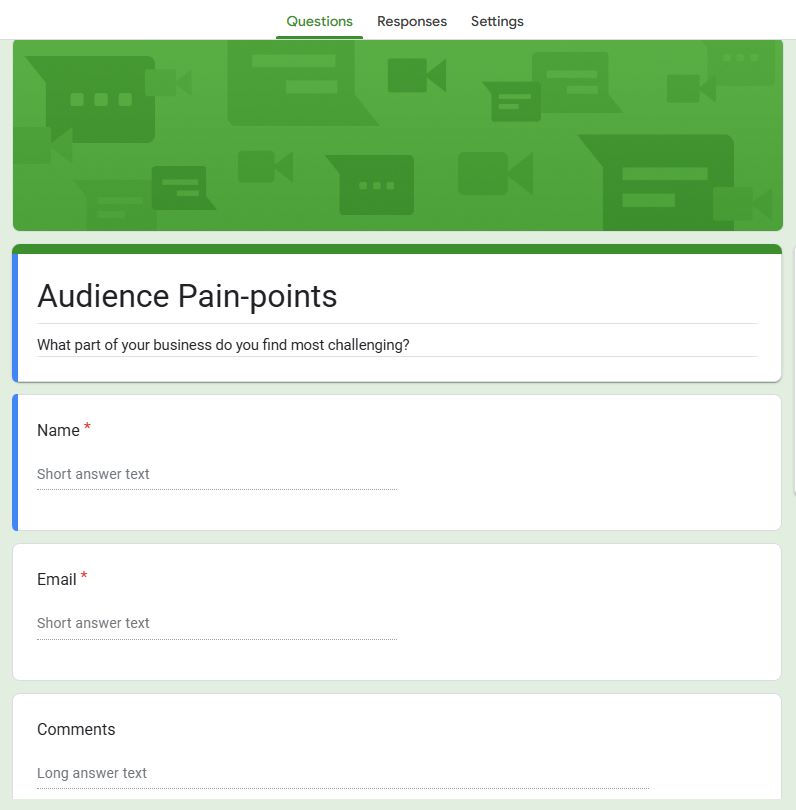
These tools are user-friendly, with pre-made survey templates you can customize to get feedback from your audience.
When you’ve gathered a considerable amount of data, use it to create customer personas. Why? It describes your ideal client in detail.
Example images of customer personas.


Image source: WordStream
It includes crucial aspects of your ideal client, such as demographic details, behavioral patterns, their most significant challenges, and other specific needs.
So, knowing your audience/customers’ struggles and interests enables you to tailor your strategy and determine the best marketing channels for content distribution.
This feature is vital as 76% of consumers prefer to buy from brands that personalize their content. For this, over 80% of online shoppers will share their details with brands to create personalized experiences.
You can use Social Media Analytics and Google Analytics insights to understand your target customers.
3. Audit Competitors’ Content Strategy
Why is auditing competitors’ content crucial? Because the data/intelligence gives you an edge over the competition. The insights are vital elements in developing a robust content plan.
You will obtain valuable information about what drives their successes and discover opportunities or gaps that you can fill to scale your small business.
Based on the records, you can use their strengths and weaknesses to improve and amplify your strategy. This approach leads to creating and distributing more helpful content that meets readers’ needs, boosts SEO performance, and improves your approach to creating engaging content.
How can I audit my competitors’ content strategy?
Begin by identifying who they are. Before doing anything, you must define the marketers and brands competing with you for Google’s top spot.
So, here’s what to do:
Look for your competitors and list them out
When researching the competition:
- Google’s top spot changes frequently. So, analyze your direct and indirect competitors to understand the market environment and strengthen your strategy. Conduct industry research to see whose names appear regularly.
- Explore the top social media sites to determine who your target audience engages with on relevant subjects.
- Do keyword research on related topics to see which websites appear and make a list of them.
Analyze your competitors’ content strategy.
Auditing their content helps you understand their approach to content creation and what content types and formats work for them.
As a result, look at the topics they write on regularly to identify themes that perform well. It helps you find related new topics and keyword opportunities.
Consider content length, quality, & publishing frequency
Look at the length of their posts to determine the standard size and depth of information on their pages to understand audience preferences.
Further, assess their publishing ratio to know how consistent they are and how often they publish new articles. These steps will guard your content creation and publishing schedule.
Study competitors’ SEO strategy
To gain valuable insights from their SEO strategy, use SEO tools like Ahrefs’ Content Gap feature, Semrush’s Keyword Gap, or your preferred competitor analysis tool to track competitors’ focused search terms.
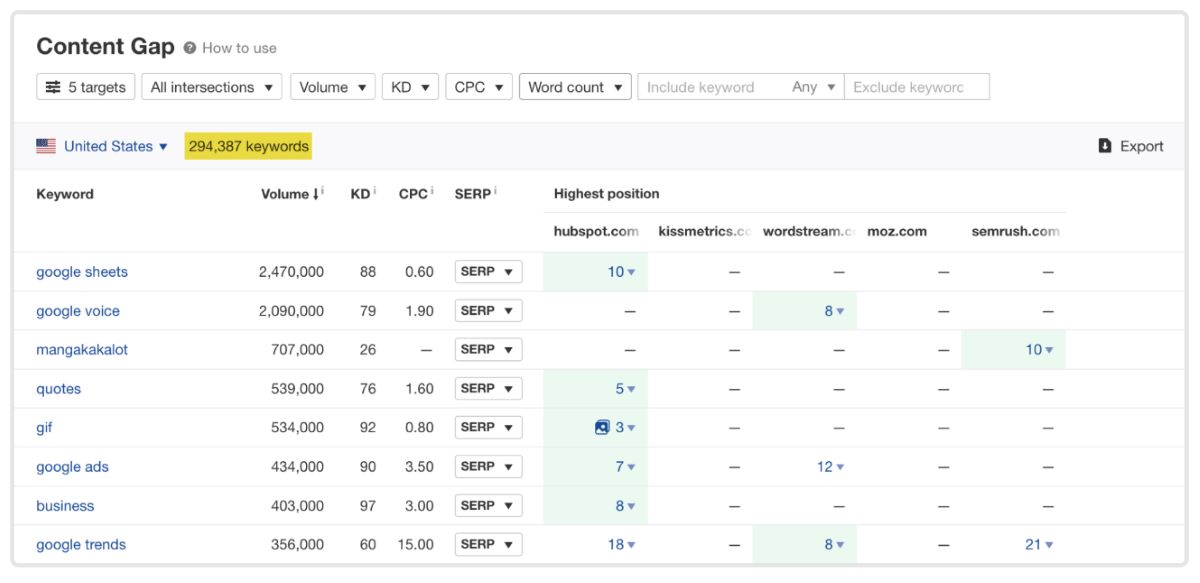
Image source: Ahrefs Content Gap feature
Let’s use Semrush Keyword Gap for this illustration:

Image source: Semrush Keyword Gap tool
Semrush’s SEO software lets you enter four rival websites and make a comparison. The result shows you the keyword overlap report, where you find standard search terms for which you and the competition rank.
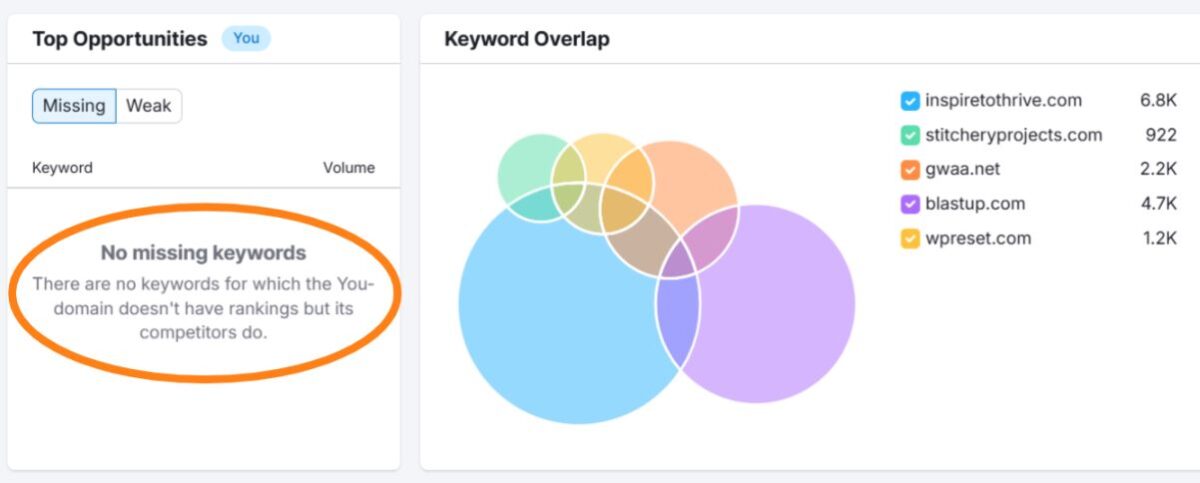
You’ll see “Missing” terms for which your competition ranks, but you’re not. It also shows you “Weak” search terms that put your competitors higher on SERPs than you.

This report shows that the InspireToThrive website ranks well for all its competitors’ keywords. However, she’s ranking lower on SERP for one “Weak” search term.
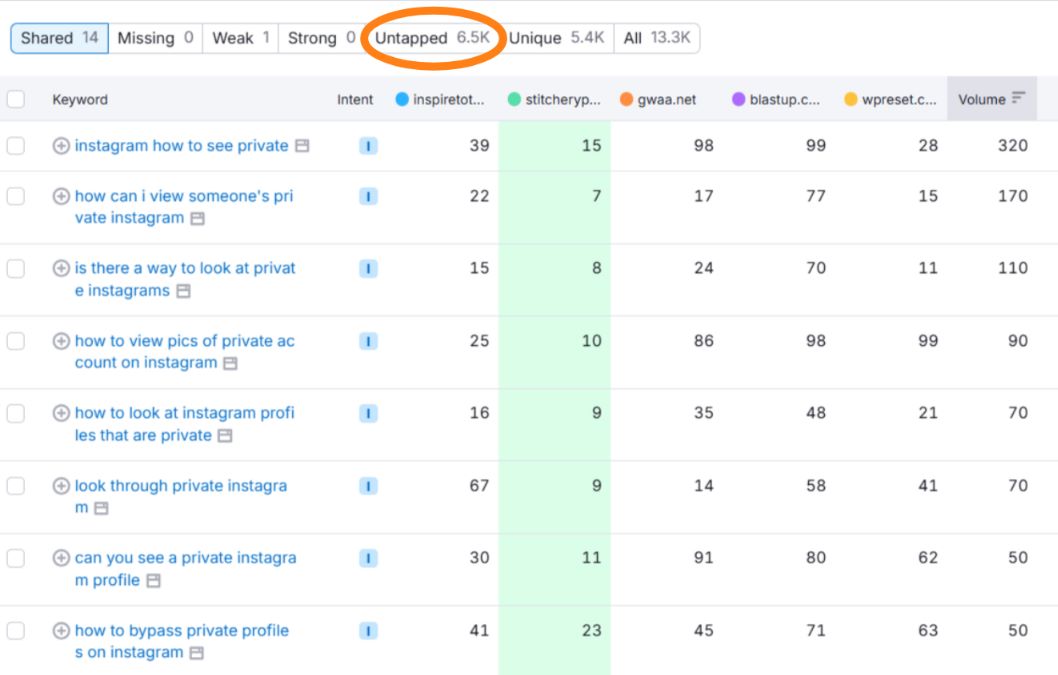
So, filter your research further to find more hanging fruits.
How?
Access the “Untapped” feature to find more related keywords you are not ranking for, but your competitors rank on those terms. Focus on long-tail keywords with high search volume since they have less competition.
Furthermore, study competitors’ backlink profiles for top-performing content and examine the links’ quality and relevance. Also, review their methods for optimizing content for better performance.
In doing so, inspect their:
- Title tags
- Header tags (H1, H2, H3, and more)
- Meta descriptions
- Internal link structures
- Image optimization tactics.
The analysis will help you understand competitors’ On-page SEO strategy and identify improvement opportunities. As a result, you can create more targeted SEO-optimized content that would increase visibility and boost SERP rankings.
4. Develop a Unique, Authentic Voice for Your Content
Why should you develop a unique, authentic content voice?
Because it helps maintain a consistent brand tone that stands out in your industry. It helps authentically communicate your brand values and personality in a meaningful and relatable way that builds trust with readers.
Come to think of it, your audience is no longer interested in perfection; they prefer interacting with approachable, authentic, and relatable businesses.
Please consider the following statistics:
- 95% of companies resolved to boost investment in authentic, relatable content
- Over 60% of buyers will support a business that aligns with their values
- For 90% of respondents, authenticity impacts their decision to support a business
- More than 80% of buyers want more authenticity from marketers.

Here’s how to develop an authentic voice:
Gain knowledge of your ideal customers
This method involves using tools like Google Analytics to identify on-site user behaviors.
Notwithstanding, use reliable social listening tools to track audience discussions, trends, and sentiments about your business.
The analytics report enables you to produce authentic content and tailor your voice accordingly.
Maintain a consistent brand voice
In this approach, you must be flexible while maintaining a cohesive marketing tone. As an illustration, use a cheerful content tone for blogs and a formal tone for business reports.
However, your social media voice would depend on the platform, the message you want to convey, and the audience group you’re targeting.
For these reasons, your tone could be:
- Casual and conversational
- Clear and concise
- Engaging and playful
- Authentic and relatable
- A professional tone for a site like LinkedIn.
The idea is to ensure coherence across platforms irrespective of your messages.
Use user-generated content (UGC)
How does UGC contribute to developing a unique, authentic voice for your content?
User-generated content provides concrete proof to prospective clients that the experiences shared by those who used your service or product are authentic.
Infact, almost 60% of buyers say UGC is the most authentic content:
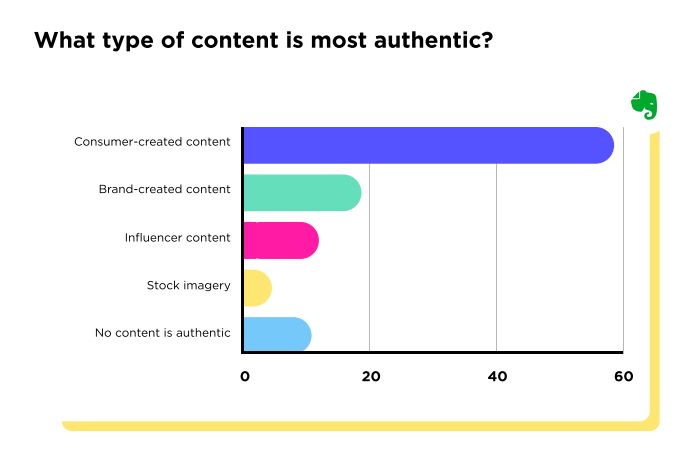
Source: Nosto-Stackla
It strengthens brand authenticity, boosts credibility, and improves engagement. Therefore, motivate people who use your product or service to share their experiences with you and on various platforms.
Then, repost the content across channels to build trust and increase the possibility of potential customers engaging with authentic and relatable content. It helps you create a loyal fan base for your business.
Ensure content aligns with your brand values
Why is this approach significant?
Aligning content with values promotes trust among your followers, as consumers have higher chances of supporting a business they view as authentic and relatable.
Notwithstanding, it reinforces your personality, sets you apart from the competition, and helps customers recognize and remember you.
For example, if your business cares about fairness, reflect it in your content. That’s how you build an authentic and unique voice for your content. In this way, you demonstrate that you’re walking the talk and not just talking the talk.
5. Brainstorm Content Ideas and Formats
With the information gathered, choosing what topics to write resonate with readers and boost engagement is only appropriate.
While studying your target tribe and competition, you discovered topics your audience engages with the most on social media. You also found relevant themes that your competitors publish regularly to increase audience interaction.
List those content ideas you found engaging during audience and competitor research, and start writing around them.
To generate more topic ideas, use a robust keyword research tool to find keywords that attract significant traffic with low competition. For this, concentrate on long-tail search terms as they have low competition and high search volume.
The Google “People also ask” feature might be the first place to look when conducting a Google search. Please consider the screenshot; I searched “Copywriting for beginners.”

On the search results page, scroll down to the “People also ask” section and explore the queries. This section usually displays only four long-tail search terms.
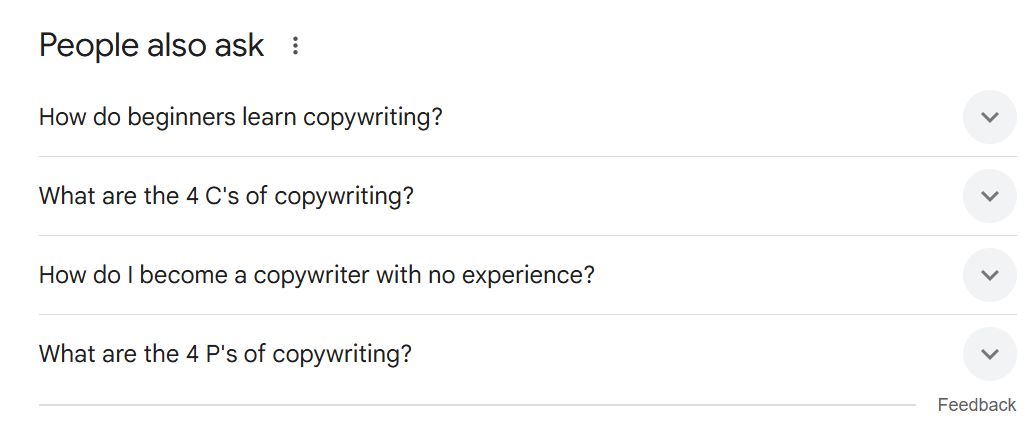
However, you can get more relevant content ideas by clicking any down arrow in the far-right corner of a question.
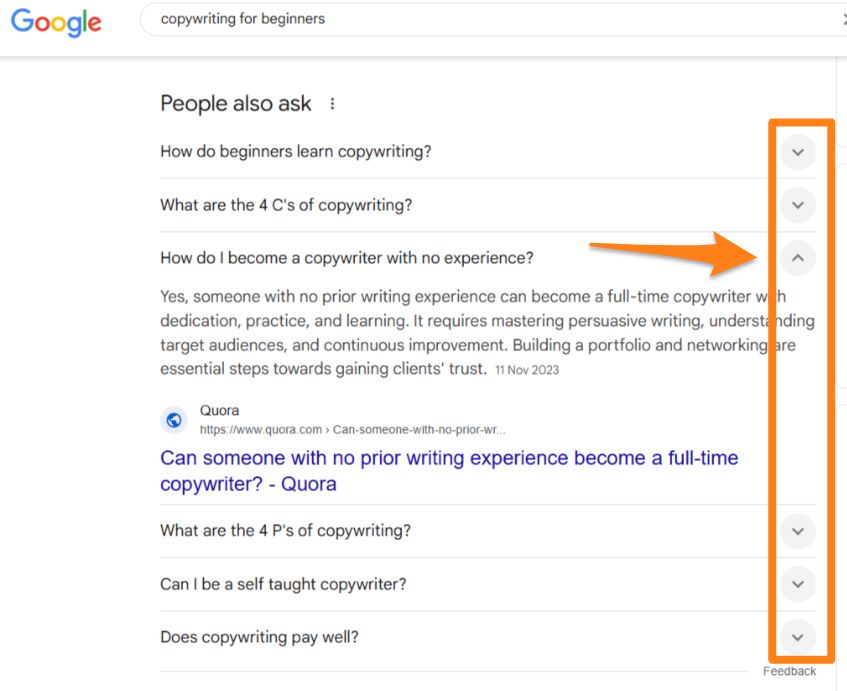
Clicking the arrow will populate more queries for creating valuable content because they are questions and concerns from your target audience. The more down arrows you click, the more topic ideas you generate.
Consider the formats (blog posts, short/long-form videos, podcasts, etc.) that perform well when brainstorming topic ideas. This strategy will help rank your content quickly at the top of search engine results pages (SERPs).
6. Research Competitors’ Content Distribution Channels & Find What Works
Your content strategy won’t turn heads if you fail to determine the top-performing content distribution and promotion platforms. Nobody will see or interact with your posts because you may be promoting on the wrong platforms.
How can you determine the best marketing channels?
This point is where exploring competitors’ content distribution channels becomes crucial. You must figure out how your competition circulates content online.
Dig deep to know their content marketing platforms and which ones drive the most results.
How?
Explore these content promotion channels:
- Blogs & website content: Analyze their blogs and websites to know if they update their blogs frequently and maintain a refreshed resource section on their website. This approach provides valuable insight into their SEO strategy, keywords they’re targeting, and the type of content they prioritize to attract organic traffic.
- Social media: Research which platforms the competition uses to generate marketing results. You will learn how your target audience consumes content and spends their time online.
- Paid advertising campaigns: Determine whether they use paid channels such as Google Ads, social media sponsored posts in one’s newsfeed, and native advertising platforms. Analyzing these distribution channels can help identify high-performing content and targeting strategies that yield results.
- Email marketing campaigns: Find out whether your competitors use email marketing for content distribution. If they do, assess how frequently they send out email campaigns and the types of content they promote.
- Influencer marketing: Are they using this influencer marketing strategy to increase content reach for better conversions? Dig deeper to discover if they collaborate with influencers on content and consider the potential to form influencer partnerships to scale your business.
7. Develop a Robust Content Creation Calendar
Why do you need a content creation calendar?
Because it facilitates the content production process, saving you an enormous amount of time while driving better outcomes.
That’s not all…
An editorial calendar helps you monitor the content creation processes, create invaluable content, and maintain a regular posting or publishing schedule.
Besides, a systematic calendar ensures your content initiatives harmonize with overarching business objectives to maintain coherence.
What are the best content calendar tools?
The following tools are excellent options to create your calendar:
- Trello
- Asana
- Basecamp
- Monday
- Google Sheets
For instance, you can use Trello to manage your workflow and collaborate with team members using boards and categorized cards, which improves productivity.
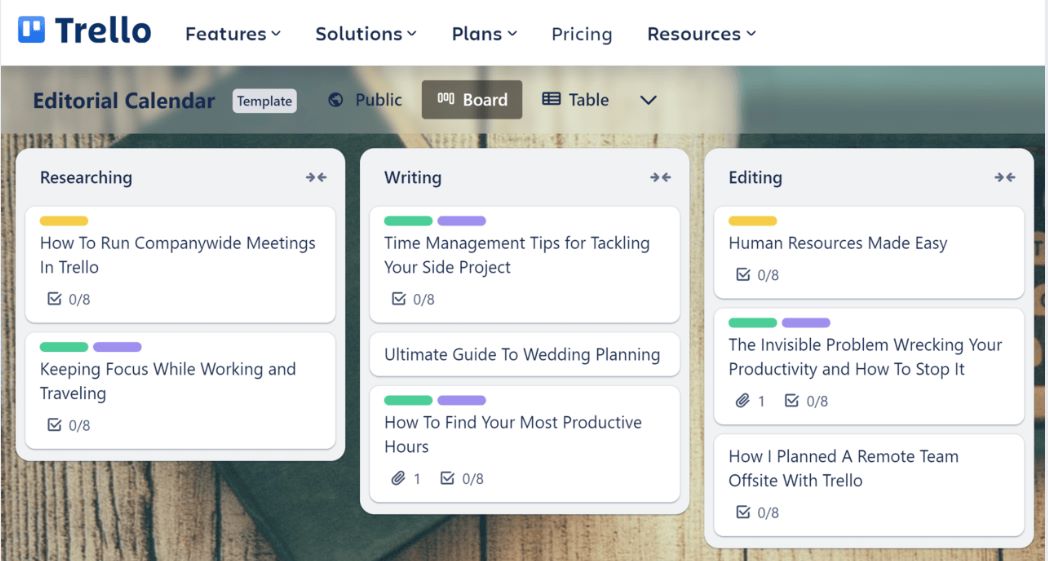
The software also provides several templates to streamline the process.
So, gather all the information you obtained earlier during your research to plan your content. Add all development stages and types of content, and ensure each material matches your content production goal.
8. Record Your Content Strategy
An undocumented content strategy is like a recipe without measurements. In rare cases, guessing may work, but the results are rarely consistent.
A content marketing statistic compiled by Adam Connell shows that only 40% of B2B marketers document their content strategies.
It means that the remaining 60% have undocumented strategies or no strategy. You want to be strategic and make the most of content production by documenting your strategy.
Documentation helps you easily navigate conte
nt development processes and prevents you from getting lost or retracing your steps. More importantly, when you record it, you can always make adjustments and fine-tune your strategy as desired to meet current market trends and demands.
How to document your content strategy
Use this simple structure to start documenting your strategy:
- Spotlight your content production and marketing target.
- Pinpoint your target demographic and the media they prefer.
- Highlight core themes or topics you will focus on. Ensure the subjects meet the audience’s interests and your brand’s mission.
- Write what kind of content you’ll be producing and where it will be most effectively distributed.
- Include deadlines, publishing dates, and responsibilities.
- Set measurable key performance indicators (KPIs) like engagement rates, click-through rates, time on page, and conversion rates to track progress.
- Write down any tools you’ll use for creating, managing, and analyzing content. Also, outline the workflow roles, from brainstorming to publication.
- Add details about tone, style, and branding elements to keep your content cohesive.
- Record how often you will revisit and adjust your document based on feedback to improve content performance.
This documentation tactic creates a solid foundation for your content production plan and affirms that every team member is on the same page.
9. Measure & Refine to Boost Content Performance
If you don’t measure performance, you might get the results you want without even knowing it. A vital tool for this purpose is analytics. Decide which KPIs to monitor and use reliable analytics to measure content success.
Choose KPIs based on each marketing channel, such as:
- Blog KPIs
- SEO KPIs
- Social media KPIs
- Email marketing KPIs
Analyze the relevant metrics for efficiency and use the insights to refine your strategy to increase the return on your investments (ROIs).
Conclusion: Creating a Successful Content Strategy
To win with content marketing, you need a well-planned content strategy framework to optimize workflow and maintain consistency. It may seem challenging to implement.
However, applying the steps in this guide will help you create and document an effective content strategy that conforms to your small business goals.
Documenting it allows you to revisit your strategy and update it when necessary to meet current trends and market demand. So, start by determining who your content is for and your primary keywords.
Then, create a calendar and focus on building and distributing content formats your audience finds exciting while maintaining your brand voice.
So, develop a blueprint to amplify your content marketing endeavors and open up potential growth opportunities. It helps increase engagement at all stages of the customer journey.
Frequently Asked Questions (FAQs)
If you have more questions that need answers, consider the Qs & As below:
It is a coordinated scheme or plan for creating and distributing content. It helps you decide what marketing content to produce, the audience to target, when to share or promote the post, and more.
An effective strategy for your website content effort contains many crucial ingredients. These include a well-established purpose or target, a robust content plan, an editorial calendar, knowledge of your ideal readers, the best content distribution channel, how to track content performance, and others.
The purpose is to help plan, create, and share valuable content to engage your audiences, build trust, and achieve business goals. TThe purpose is to help plan, create, and share valuable content to engage your audiences, build trust, and achieve business goals. This aim guarantees coherence and relevance across sites.his aim guarantees coherence and relevance across sites.
To measure the success of your content strategy, analyze the key metrics (organic traffic, audience engagement, SEO performance, conversion rates, and others) to see how well your content is performing.
- How to Create an Effective Content Strategy for Your Website (9 Easy Steps) - May 8, 2025
- The 7 Best Ways For Social Media Lead Generation in 2025 - January 14, 2025
- How An AI Instagram Tool Like Kicksta Can Grow Your Instagram Followers - August 30, 2024




Your article was truly insightful! I particularly appreciated your in-depth analysis of the topic, and the practical tips you provided are going to be very useful for my own endeavors. Thank you for sharing your expertise!
Hi Miranda, Welcome to Inspire To Thrive. You are most welcome. Which one of the tips did you like the most? Thanks for coming by and have a wonderful day.
Hi Miranda, I’m glad you found the article insightful and practical. It means a lot to me that you appreciate the analysis and find the valuable tips helpful. Sharing value is rewarding, and I’m thrilled to have contributed positively to your endeavors.
Hey Moss,
These days, content are apparently king but writing content that rules over your competition is not that simple.
We know very well in this industry, in order to boost traffic and revenue, it’s essential to invest potential in relevant content development.
The definition of quality may change depending on the sector you are targeting or the target audience but there are many common elements that serve as reliable indicators.
Thanks for exploring these significant points with us.
With best regards,
Amar Kumar
Hey Moss,
It’s good to see you here.
As you discussed, ubbersuggest is really a great tool to provides the blog ideas around the topics we would like our website to rank on. Aside from that, Google trends or Buzzsumo also play an effectual role in terms of making a good content strategy. Nowadays it’s become a necessity to figure out the content that our target audience wants.
Your article is actually worth reading, thank you for sharing it. ?
Hi Moss,
When it comes to making a content strategy, I really prefer to make plans for like 6 months or so. I just find topics using Google Trends and also use some paid tools to find the best content to write for.
For curating a great content I also do competitors as well as keywords research so that my content performs well on the SERPs.
Really, in this post, I have found some amazing tips that I’m gonna use for sure in order to make an effective content strategy.
Thanks for sharing such a great post. Keep sharing.
Hi Jitendra,
That is why itis called a strategy. It takes time to create for optimal results. So giving it time in advance as you stated will help you get the necessary information that will enhance your strategy.
You have to perform research on your competition to find out what they’re doing, what keywords they’re ranking for, and how you can outperform them. All these take time.
Thank you for topping byand adding to the discussion.
Hello Moss,
Awesome post. Content still plays a great role in web advertising. You need to create quality and helpful content to leverage the power of content marketing. Keyword research is very important to drive targeted traffic from search engines. Thanks for sharing this helpful post.
Regards,
Vishwajeet Kumar
Hi Vishwajeet,
I do agree with you 100% because content is the backbone of today’s digital marketing strategy. If done right, you can quickly grow your business beyond imagination in the shortest time possible. Thanks a lot for your contribution.